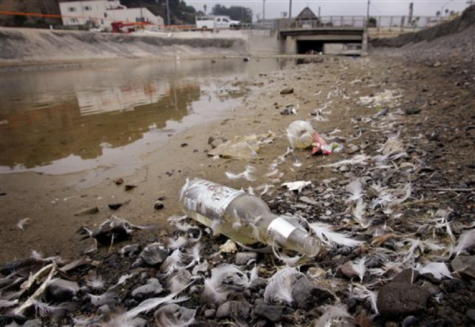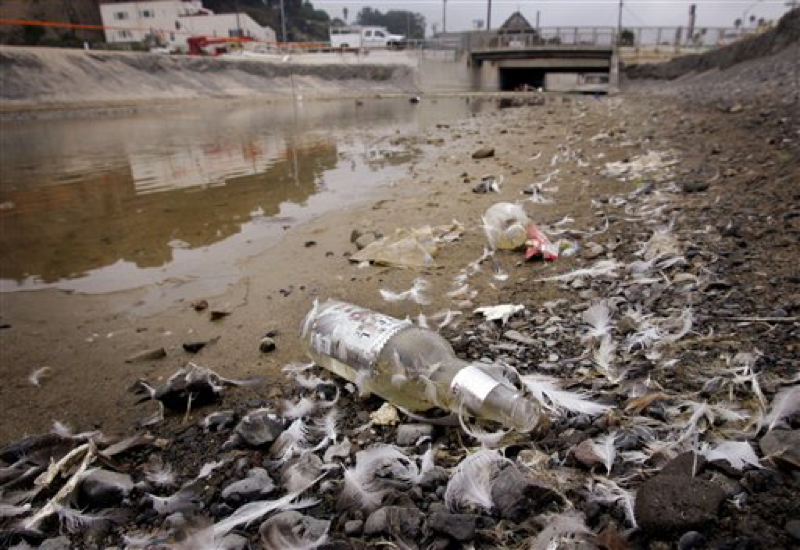Five Ways to Limit Environmental Impact in Summer
Debris and standing water collect at the outflow of the creek that drains into the ocean from Santa Monica Canyon, at Will Rogers State Beach in Los Angeles Thursday, Sept. 14, 2006. Seven years ago, a federal consent decree set in motion a process to clean up some of the nation’s most popular beaches rimming Santa Monica Bay, waters polluted with a brew of contaminants from animal droppings to fertilizer. The 13 cities that surround the bay were given until July to do something about the pollution or pay big daily fines. However, the deadline has passed and many of the beaches still aren’t clean, prompting the Los Angeles Regional Water Quality Board to consider ways to make enforcement easier. (AP Photo/Reed Saxon)
June 10, 2017
Five ways anyone can limit their environmental impact, simple.
With summer coming up and school letting out, it’s time for people all over to let loose and relax. Whether it be going to the beach, going on a picnic, or simply relaxing at home, it seems like everyone is trying to get their fix of summer.
That being said, 2016 was the hottest year to date, according to The New York Times. Of the top 17 hottest years, 16 of them have occurred since 2000, and scientists only expect the temperatures to climb.
The heat isn’t the only impact humans are having on the environment. Air pollution, as well as water pollution, both create problems. However, there are things that can be done. From limiting plastic use to getting out and walking more, here are five things anyone can do this summer to limit their negative environmental impact.
First step: sunscreen.
A simple summer staple that virtually all Americans use in the summer could be polluting the oceans according to Vogue. An ever developing body of information shows that chemicals like oxybenzone may be harmful to wildlife. By killing changing coral DNA and causing them to appear healthy, chemicals like oxybenzone and octinoxate are detrimental to the environment. But, by simply switching sunscreen brands to one that doesn’t contain these chemicals (Haereticus Environmental Laboratory gives a list of all chemicals to avoid), the problem can be avoided and even diminished.
And, if buying more sustainable sunscreen doesn’t come easy, people should try limiting sunscreen use by limiting time in the sun or wearing more protective clothing.
Next, biodegradable kitchenware.
Visiting the beach or going on a picnic is a very popular summer activity; however, it can cause some major environmental problems. In 2012, nearly eight million tons of plastic were found in the marine ecosystems. The issue is that plastic is amazingly durable. It can last centuries
without degrading, so when it enters ecosystems, it can stay there for a very, very long time.

In an attempt to save the planet, and the animals, using biodegradable kitchenware for picnics and beach trips could help. Try using cloth napkins, reusable plates and cutlery, glass or metal cups/straws, as well as reusable bottles.
Try finding alternatives to typically plastic products, or at the very least clean up and recycle the plastic products used.
Going along with biodegradable kitchenware is avoiding plastic bottles.
In 2015, only about 32% of all plastic in the United States, just under a third, was recycled. Roughly 40% ends up in landfills and 14% is burned. As for the last 32%, it ends up in the oceans or other ecosystems according to The New York Times.
Switching from plastic bottles to reusable bottles reduces plastic in ecosystems like the ocean, greenhouse gas emissions from plastic production, and helps reduce toxins from being emitted into the atmosphere says CNN.
If that’s not enough, buying a plastic water bottle everyday, at least in the state of New York, would set you back roughly $365. However, if you refill a single-serving plastic bottle everyday, you would only lose about 63 cents, on top of the initial $1. By reusing the same bottle everyday you could save roughly $362 every year according to The New York Times.
Next, onto travelling.
Summer tends to be the time of year people go on vacations, and with vacation comes travelling. The issue begins with the amount of carbon put into the environment from these travels. Transportation accounts for 29% of greenhouse gas emissions according to the Federal Transit Administration (FTA).
In 2015 alone, nearly 6,587 million metric tons of carbon dioxide was emitted from cars, planes, and other forms of travel according the to U.S. Environmental Protection Agency (EPA). To put that in simpler terms, a small car weighs roughly 1 metric ton. That means the amount of CO2 put into the environment from travelling was roughly the size of 6,587 million small cars. That’s a lot of carbon dioxide.
In an attempt to reduce the carbon footprint and save the environment a bit, there are two main things anyone can do.
The first is carpool. By limiting the number of cars on the road, people would limit the amount of CO2 put into the environment. Carpooling can drastically improve air quality, reduce greenhouse gas emissions, and increase land conservation says the FTA.
The second is reduce air travel. The issue with flying is that all carbon that is produced goes directly into the atmosphere. And while flying is a quick and easy way to travel, it can be quite detrimental to the environment. Planes alone produce roughly 12 of the 29% of greenhouse gases emitted from travelling according to the EPA. And while completely avoiding flying may not be possible for the average person, there are things anyone can do to offset their carbon footprint.
Air companies like Quanta reduce their carbon footprint by completing offset projects, many of which include planting trees in rainforests or completing contained field burns to protect against unwanted wildfires. Every time someone books a flight with Quanta, they allow that person to pick an offset project to contribute to. Quanta then bases their contribution to the project based on the number of miles that person will be flying.
And, finally, reducing meat consumption.
The summer months tend to be a big time for barbecues and family cook outs which typically means more hot dogs and burgers for many American families. However, the meat industry can be severely damaging to the environment.
The meat industry is one of the largest contributors to the greenhouse gas emissions according to The Pitt News. The most abundant greenhouse gas emitted by the animal industry is Methane, a chemical that is 23 times as harmful as carbon. In fact, it is the most prevalent contributor to global warming. But, limiting meat consumption to just a few times a week, the emissions produced by the mean industry could be reduced by one-third by 2050.
While doing all of these things all the time may be difficult for many people, employing these habits could create a drastic impact on the environment. In a good way. Whether someone’s going on a picnic, going to the beach, hosting a cookout, or simply going to work, minor changes in their everyday habits can, and will, help the environment in the future.



